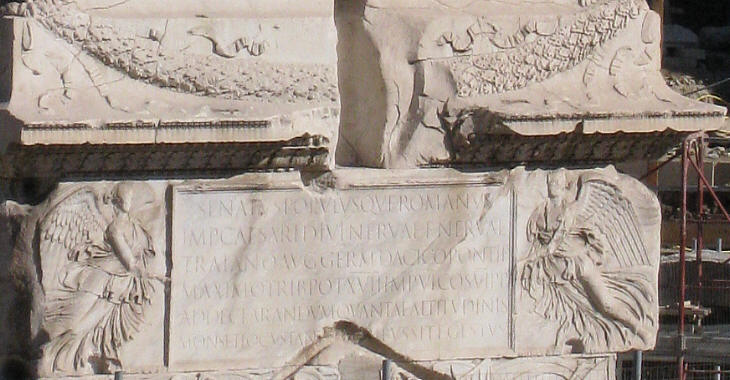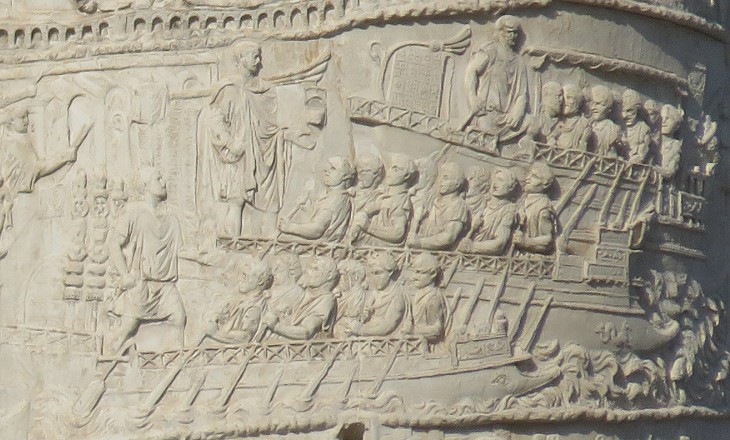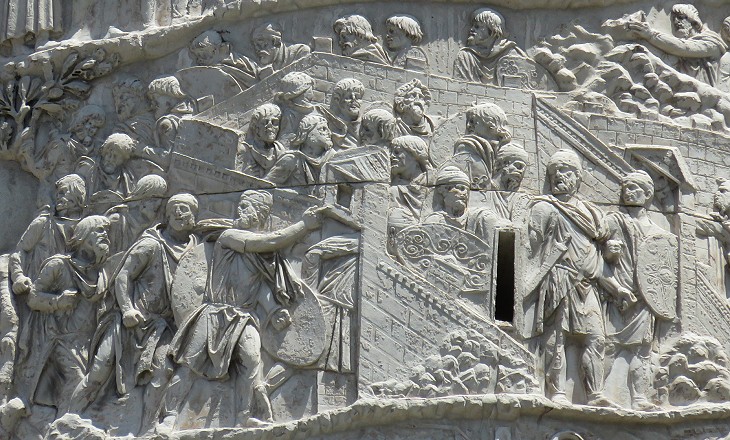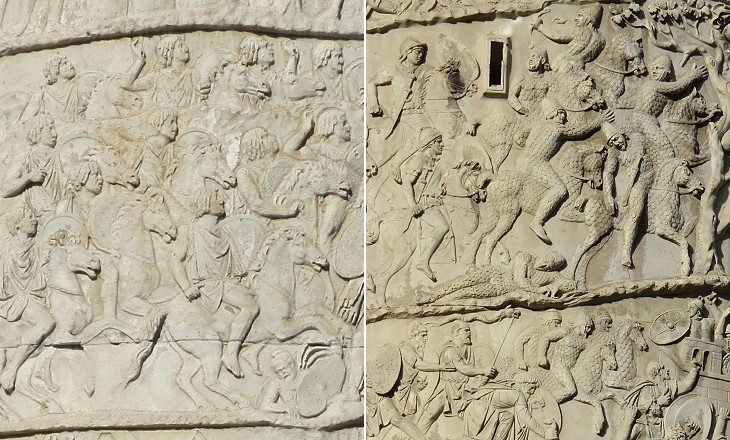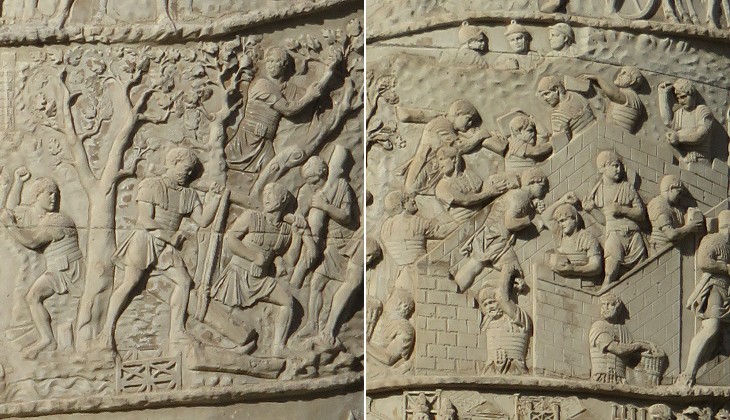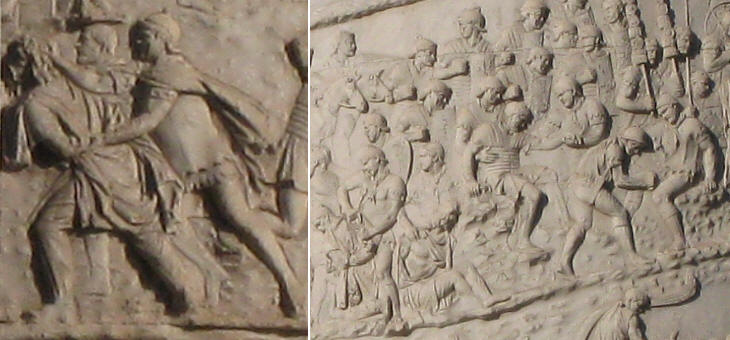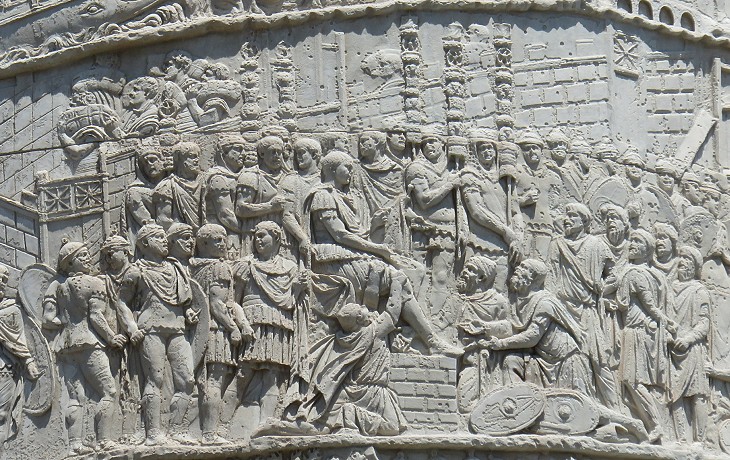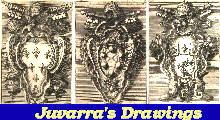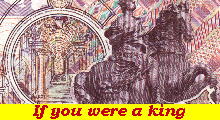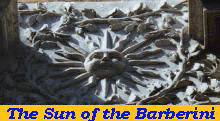  What's New! Detailed Sitemap All images © by Roberto Piperno, owner of the domain. Write to romapip@quipo.it. Text edited by Rosamie Moore. |
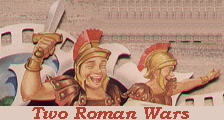 Two Roman Wars Two Roman Wars
In 97 AD Emperor Nerva appointed co-emperor the general Marcus Ulpius Trajan, who added Nerva to his name and for this reason was regarded as Nerva's adoptive son. The Senate ratified the decision by which for the first time the highest responsibility of the Empire was entrusted to a representative of the provinces (Trajan was born in Spain). The other remarkable aspect of the decision was the definition of a process for the appointment of the emperors ("succession by adoption") which lasted for more than eighty years and gave to Rome the greatest Emperors: Trajan, Hadrian, Antoninus Pius and Marcus Aurelius. The emperors who ruled Rome in the Ist century AD had basically a policy of containment of the possible threats to the Empire: in Europe the threat came from the German tribes beyond the Rhine and the Danube, in Asia from the Persian or Parthian empire and in Africa from the Moors. The Roman policy was aimed at reducing these threats by establishing alliances with minor tribes (in Europe and Africa) or kingdoms (in Asia), rather than at expanding the borders of the Empire. Trajan, with the support of the Senate, changed this policy in favour of an expansion of the Empire, also to react to some economical difficulties arising from the cost of the military expenditure. The target of the expansion was Dacia, a kingdom beyond the Danube which included a section of the Carpathian Mountains known for its rich gold mines. In today's world Dacia corresponds to most of Romania plus eastern Hungary. In 64 AD Emperor Nero had diminished the gold content of the Roman coins and this had led to financial trouble with coins having the same official name, but different levels of gold. Trajan thought that the gold of Dacia could help in solving the economical difficulties of the Empire. The war erupted in March 101 and it was justified by raids of the Dacians in the Roman region of Mesia (today's Bulgaria), but Trajan had been preparing the war since 99 when he visited the region and approved the opening of a street on the right bank of the Danube and the fortification of several sites. The Romans defeated the Dacians at Topae, set fire to several towns and moved towards Sarmizegetusa, the capital of the kingdom. At this point Decebalus, the king of Dacia, accepted the conditions imposed by the Romans (which included the disarmament of the Dacian fortresses along the Danube) and a peace treaty was signed. In 105 Trajan declared that Decebalus was in breach of the disarmament clause and sent him an ultimatum. Decebalus reacted by attempting to attack Mesia, but he was repelled and gradually forced to retreat to Sarmizegetusa. The Romans laid siege to the town and cut its water supply. The Dacians eventually surrendered and Decebalus committed suicide. Dacia became a Roman province.
Senatus Populusque Romanus Imp(eratori) Caesari Divi Nervae f(ilio) Nervae Traiano Aug(usto) Germ(anico) Dacico Pontif(ici) Maximo Trib(unicia) Pot(estate) XVIII Imperatori VI Co(n)s(uli) VI P(atri) P(atriae) ad declarandum quantae altitudinis mons et locus tant(is ope)ribus sit egestus. The Senate and people of Rome to Emperor Caesar, son of blessed Nerva, Nerva Trajan Augustus conqueror of Germany and Dacia, Highest Pontiff 17 times tribune, 6 times imperator, 6 times consul, Father of the Nation: as an illustration of the height which this hill and place attained, before they were removed for such great works as these. The Dacian wars were celebrated in the Trajan's Column. The reliefs, apart from their artistic value, are an interesting example of war propaganda. Here below a short comment on some episodes described in the reliefs.
The Roman fleet was made up of triremes, warships with three banks of oars, which allowed them to move regardless of the prevailing winds. The relief shows that Trajan was able to rapidly move across the seas. He is standing on the central trireme while he delivers a speech to the troops. The lamp near Trajan means that the Roman fleet could travel also at night and the high waves and the dolphins mean that the fleet did not move along the coast, but it was capable of crossing the open sea. All these details had the objective of highlighting the Roman capability of rapidly deploying troops in case of conflict. Notwithstanding the fact that Trajan's background was a military one and that he personally led the campaign, the reliefs show him in situations where he is not directly involved in battles. He is portrayed: a) in the ritual ceremonies which preceded the main war events; b) while he delivers speeches to the troops; c) while he is shown evidence of the Roman victories or he receives the surrender of the enemies. The intent was to put the emperor on a special footing where he was not involved in the specific events of the war, which as all wars do, had its ups and downs.
The second Dacian war originated from the violation of a disarmament clause included in the peace terms which ended the first war. The relief shows the "smoking gun" i.e. the purported violation of the clause. We see the Dacians wearing weapons and gathering inside a fortress. The slightly taller man inside the fortress is Decebalus, the king of the Dacians: while the viewers were able to identify Trajan by his face, his opponent was made identifiable by his height. The costumes of the Dacians show that the Romans did not consider them a savage population, because they are shown wearing elaborate dresses and a hat.
In addition to Romans and Dacians the reliefs show some other troops: on the Roman side the relief above (left) shows the chivalry of the Moors: the viewers were able to identify them by their frizzly (almost "rasta") hair and by the fact that they rode without saddle. In other episodes the Romans are helped by German warriors (almost naked and with moustaches) and by archers wearing an elaborate Oriental costume. The fact that we see on the Roman side representatives of their fiercest enemies may mean that Rome was at peace at that time, that the borders of the empire were secure and that the Dacian war had the support of the whole world. On the Dacian side the reliefs show the Sarmatian chivalry: both the warrior and the horse wear a reptile-like scale armour. It is interesting to note that immediately above the relief showing the arrival of the Sarmatians, we see the body of a dead Sarmatian chevalier. In this way the viewer immediately sees the end of the enemies of Rome. This "trick" is used also in other episodes showing the Dacians on the attack and, immediately above this scene, their dead bodies or their rout. The Sarmatians lived in the vast plains of southern Russia and Poland.
In 9 AD Arminius, a German officer in the Roman army, convinced General Publius Quintus Varus to make a punitive expedition against the German tribes which from time to time threatened the Roman colonies in the Rhine valley. Three Roman legions marched well into hostile territory and following the advice of Arminius they entered the deep Teutoburg forest (near today's Detholm). At this point Arminius abandoned the Romans and the Germans of his tribe (the Cherusci) attacked the legions in a series of ambushes. The Romans were unable to move in the forest and to use their superior military skills and equipment. The Germans spared just a few legionaries to let them bring the news to the emperor Augustus in Rome. The head of Publius Quintus Varus was sent to other German tribes to promote a general rebellion against the Romans. Eventually the head was sent to the Romans. According to Svetonius, Augustus cried out: Vare, legiones redde! (Varus give me back my legions). Seven years later the Romans took their revenge and Arminius was defeated by Julius Caesar, a nephew of the Emperor Tiberius, who is generally known as Germanicus, the additional name he was given for his victory. In the XVIIIth centuries Arminius was hailed as a national hero and a precursor of the German nation. The defeat suffered by Varus had lasting consequences on the Roman expansion in Europe and its memory can be seen in the numerous reliefs of the column which show Roman legionaries in the act of cutting down trees and building fortified camps, reliefs aimed at reassuring the viewers that Trajan was not repeating the mistakes made by Varus.
Some reliefs show the aftermath of war: Dacian prisoners are shown while they are being tied and blindfolded. The prisoners show a rather submissive attitude as if they were agreeing to these actions. The reliefs do not show casualties on the Roman side: the obvious question: what about our troops? is answered by reliefs showing Roman legionaries taking care of some wounded soldiers who are helped to walk or are bandaged.
The first Dacian war ended with a peace treaty: the event is celebrated in a very complex scene where we see desperate Dacians pleading for mercy, after having thrown away their weapons. The Dacians are not portrayed as enemies, but rather as persons converted to a new faith. The relief shows the need for the winner to see his actions justified by the confession of those who surrender that they wrongly acted. The viewer is shown a religious ceremony and the processions of Romans and Dacians are both converging towards Trajan in the act of saying Pax (peace). The verticality of the Roman military symbols balances the horizontal lines of the processions. On the left side the viewer sees the heads of Roman legionaries carrying bags and moving away from the scene: the first Dacian war was not meant to conquer Dacia, but just to curtail its power, so having achieved their objective the Romans are already leaving the occupied country. The relief inspired many Renaissance and Baroque artists, including Velazquez, who after his stay in Rome painted the surrender of the Dutch city of Breda to the Spanish troops (see the painting). In the year 271 AD Emperor Aurelianus, the same emperor who built the walls of Rome, decided to move out of Dacia, because it was too difficult and expensive to protect that province from the raids of the barbarian tribes. The image in the background of this page shows Victory (not Truth) writing the history of the Dacian wars. To see another page dealing with the Roman army click here.  Italians in general and Romans in particular are associated with cynicism and with a tendency to swiftly siding with the winner. Maybe a cause of this attitude can be traced in their early exposure to war propaganda.  SEE THESE OTHER EXHIBITIONS (for a full list see my detailed list). |
